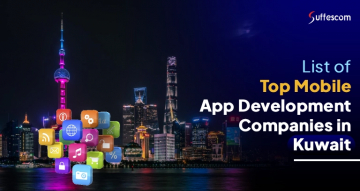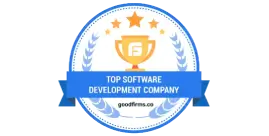E-Scooter App Development Cost: A Detailed Breakdown

Once you know everything essential about e-scooter app development cost, making a higher ROI will be a no-brainer! Analyzing the app development cost will help you understand how much does it cost to start an e-scooter rental business?
Read the blog till the end to get interesting insights on the cost breakdown of e-scooter app development.
Cost Breakdown - E-Scooter App Development
It costs between $8000 and $15000 to develop a scalable, market-ready, and fully-functional e-scooter app. Here’s a cost breakdown for you to make a wise decision and invest accordingly-
How Much Does it Cost to Start an E-Scooter Rental Business?
The costs incurred on e-scooter app development are far less than the returns against it when you get the development service from Suffescom Solutions. Just invest between $7000 and $15000 in e-scooter app development and ensure maximum returns.
| Development Component | Estimated Cost Range | Factors Affecting Cost | Cost Saving Tip |
| Planning & Requirement Analysis | $500 - $1,000 | Project scope clarity, stakeholder inputs, market research | Define clear objectives and prioritize core features |
| UI/UX Design | $1,000 - $2,000 | Number of screens, custom design complexity, branding elements | Use pre-designed templates and iterative design feedback |
| Technical Architecture & Infrastructure Planning | $500 - $1,000 | Technology stack selection, scalability requirements, integration planning | Adopt proven frameworks and reusable architecture patterns |
| Frontend Development | $2,000 - $4,000 | Feature set, targeted platforms, custom interactions, performance needs | Use cross-platform frameworks like Flutter, React Native |
| Backend Development | $2,000 - $4,000 | Server architecture, business logic complexity, scalability, security features | Leverage cloud solutions and modular coding practices |
| Database Design & Development | $500 - $1,000 | Data volume, structure complexity, performance, and scalability requirements | Utilize managed cloud databases and standardized schema designs |
| API Integration | $500 - $1,000 | Number and complexity of third-party APIs such as payments, mapping, and geolocation) | Use standardized APIs and pre-built integration libraries |
| Security Implementation | $300 - $700 | Encryption standards, data protection, and regulatory compliance | Implement standard security protocols and best practices |
| Payment Gateway Integration | $300 - $700 | Number of payment methods, compliance requirements, transaction security | Integrate off-the-shelf payment APIs |
| Testing & Quality Assurance | $500 - $1,000 | Manual vs. automated testing, feature complexity, coverage scope | Implement automated testing and continuous integration practices |
| Deployment & Launch | $200 - $500 | Hosting solutions, server setup, and app store submission fees | Use managed cloud services and deployment automation tools |
| Post-launch Support & Maintenance | $500 - $1,000 | Frequency of updates, bug fixes, performance optimization, and security patches | Build a scalable architecture to minimize long-term maintenance costs |
| Project Management & Documentation | $300 - $700 | Team size, project duration, coordination complexity | Employ agile methodologies and effective communication tools |
| Analytics & Reporting Integration | $300 - $700 | Data source integration, dashboard complexity, and real-time analytics needs | Use existing analytics platforms and standardized reporting tools |
| Additional Integrations (e.g., IoT/Smart City Interfaces) | $300 - $700 | Integration with external systems, custom API development, interoperability | Opt for modular integrations using standardized APIs |
Let’s understand the factors that affect the e-scooter app development cost. For better understanding, we have categorized the factors into different groups, as follows-
1. Clone App Based
Often, it is better to go with a clone solution. Someone else has cracked the code; you just need to follow their path. Clone application development incurs differentiative costs, as every solution is different in its own sense.
2. Lime E-Scooter Like App Development
Achieving global scalability is highly possible with the Lime e-scooter mobile app development. Considering the popularity of Lime in the United States, it naturally becomes the first choice for the clone solutions.
Think about it; Lime offers its services in over 30 countries around the globe. This states that the app has understood the assignment, and replicating such an app can bring exponential results. Since we are talking about the development cost, factors such as IoT integration, multi-region deployment compatibility, multi-currency support, and fleet management affect the cost levels.
3. Bird E-Scooter Like App Development
Another US-based e-scooter app, Bird, is operational in 400 cities worldwide. Why is Bird a promising solution? It offers a tried-and-tested pricing model, fast and robust operational workflows, and route suggestions using an effective GPS system.
Several factors will likely affect the development costs, including dynamic pricing, real-time ride optimization features, insurance & licensing models, and multi-payment gateway integration.
4. Spin E-Scooter Like App Development
Capture a niche market with Spin e-scooter-like app development solution. Experience higher user safety with reliable compliance solutions, but these provisions come at a cost affected by the following-
- Partnering with educational institutions, as Spin focuses on universities.
- Indoor GPS/parking zone support
- Smart city integrations
- High safety and geofencing features
5. Business Model Based
There are three major business models for e-scooter providers, and each one brings its own cost levels.
6. Rent-Based E-Scooter Services
Rent-based models enable the user to utilize e-vehicles as per usage. All a passenger needs to do is check for the scooters available nearby. The passenger then scans the QR code using the app to proceed with their journey. After completion, the bill gets generated as per the running time.
Get the Lowest E-Scooter App Development Cost!
Connect with Suffescom Solutions to get the best-in-class application at the lowest e-scooter app development cost. We charge fairly and provide the best e-scooter applications. Take your business to the top with our scalable solutions.
7. Development Impact
1. Tracking & Billing: The e-scooter app for a rent-based business model must track ride duration, distance, and additional factors such as battery charge, which requires GPS integration and real-time data processing, requiring additional costs.
2. Payment Integration: Secure payment gateways are a must-have for managing micro transactions, and they require additional development costs.
3. User Interface (UI): A simple, engaging, and direct user interface that allows users to easily access the app, which requires professional designers.
4. Maintenance & Updates: Since the usage is recurring, it adds a load on the systems to be managed using constant data updates and error resolution.
App complexity and infrastructure are the two major cost factors in a rent-based model. Robust real-time data and security increase the cost in contrast to basic functions such as tracking and billing. Investment in reliable GPS and backend servers, alongside the integration of payment systems, also increases the cost.
8. Subscription-Based E-Scooter Services
The subscription model allows the user to use the e-scooter for a subscribed time period. The user pays a dedicated fee as per the subscription (daily, weekly, monthly, or annually) and gets special discounts or other perks.
9. Development Impact
1. User Management & Authentication: The system must support recurring billing, subscriber management, and personalized profiles, including managing free trials, upgrades, downgrades, and cancellations.
2. Analytics & Engagement: A subscription-based e-scooter mobile app development includes standard features such as tracking user behavior and delivering insights for personalised offers, notifications, and loyalty programs.
3. Feature-Rich UI/UX: Users may need a more advanced user interface to manage subscriptions, view ride statistics, and access exclusive features. Ensuring such provisions demands a significant development cost.
4. Complex Backend Infrastructure: Regular billing and subscriber management require a secure and well-optimized backend, often integrating with third-party financial services.
Two major factors, higher complexity and scalability considerations, impact the cost levels. The subscription model requires recurring user data management, constant payment processing, and integration of third-party services, which raises the development budget.
10. Demand-Based Model
A demand-based model adjusts pricing or availability based on current demand, location, or peak usage times. Prices might surge during high-demand periods.
11. Development Impact
1. Dynamic Pricing Algorithms: The app needs to integrate algorithms that can automatically adjust prices based on real-time demand data. This requires advanced data analytics and sometimes integration with AI or machine learning frameworks.
2. Data Collection & Analysis: More data points (like time, weather, local events, or traffic conditions) must be collected and analyzed, which means the system should be designed to process and react to high-volume data streams.
3. Integration with Real-Time Services: Besides tracking rides, the app might need to incorporate external data feeds or APIs to evaluate factors that affect demand.
4. Adaptive User Interface: The UI should quickly reflect changes in pricing, availability, and promotions, ensuring users are always informed of current rates or conditions.
12. Cost Factors:
1. High Complexity: The development of dynamic algorithms and the infrastructure to support real-time data analysis requires a significant investment in both development and testing.
2. Advanced Data Infrastructure: Secure and robust databases, along with servers capable of handling rapid and variable loads, push up costs further.
3. Maintenance & Optimization: Continuous improvements and adjustments to the pricing algorithm are necessary to keep up with changing market demands, resulting in higher long-term maintenance costs.
Looking for an Affordable Mobile App Development Company for E-Scooter Apps?
End your search for the most affordable mobile app development company for e-scooter apps at Suffescom Solutions. Shake hands with a professional and hold a significant market share. Connect now!
E-Scooter App Development Cost Differs by Solution Type
E-scooter applications come in three types concerning app development. Each app has its own features, project scope, development practices, and objectives, serving various user needs.
1. MVP (Minimum Viable Product) Development
MVP apps are suitable for businesses looking to quickly enter the market. Such mvp apps developed at their core level and have enough functionalities to serve the users. MVP apps also enable the development team to iterate on the application as per the user feedback obtained in the initial market launch.
It costs between $5000 and $8000 to develop an e-scooter MVP app. Development speed, feature scope, and integration costs affect this cost range. Also, this range includes the following features, fulfilling the purpose of MVP;
- User registration
- Real-time location tracking
- Billing systems
- User profile management
- Customer support
2. Readymade/Whitelabel Solution
As their name suggests, these solutions are ready-to-launch and offer extensive customisation provisions, ideal for companies with personalized branding elements. It costs between $8000 and $10000 to get a readymade app or whitelabel e-scooter mobile app development service.
This cost range includes customizable UI themes, dashboard & reporting tools, user management, third-party integrations, and more. The following four major development components play a significant role in the process;
- Modular architecture
- Customization layers
- API-first infrastructure
- Deployment environment
3. Custom App Development
As the term suggests, the application is highly customized per the business type or requirements. Such a development type is ideal for where the prime aim is to provide a tailor-made experience.
Custom e-scooter apps enhance security and compliance as per the industry-specific regulations and data privacy laws. Also, insightful insights from custom dashboards tailored to businesses' KPIs and performance metrics for efficient decision making.
Customization brings higher costs than the MVP or readymade/whitelabel solutions. Hence, analyzing several important factors is vital, listed below;
1. Custom UI/UX design: Tailored user interface as per targeted audience
2. Server architecture: For handling backend systems
3. Custom API integration: For better control and functionality
4. Security framework: To safeguard sensitive user data
Constant mobile app development life cycle: Agile development approach
Let’s Wrap It Up!
Here’s a conclusion for
- It costs between $8000 and $15000 for e-scooter app development.
- This cost range is impacted by various categories such as business model, app type, and clone app development.
- Complete research before investing in an e-scooter app development company is a prerequisite.
As a reliable and professional on-demand app development company, Suffescom Solutions has been serving various clients across multiple industries for more than a decade. Our clients experience affordability, ease of access, and convenience when they contact us. Connect with the best and affordable mobile app development company.
Frequently Asked Questions on E-Scooter App Development Cost
How much does e-scooter app development cost?
E-scooter app development costs between $7000 and $15000. Various key factors impact this cost level, some of which are UI/UX design, features' complexity, API integration, development type (cross or native), development team's expertise and experience.
How to save costs on e-scooter mobile app development?
Some of the basic tips that will help you save on e-scooter mobile app development costs include feature prioritization, choosing cross-platform development, using open source tools, implementing agile development practices, conducting tests in the mobile app development life cycle, and effective budget control.
How to choose the best e-scooter app development company?
Identify the traits, and you will find the best e-scooter app development company. The traits of such a company include domain expertise in on-demand app development, proven track record, agile and iterative development process, user-centric UI/UX design, scalability and adaptability, transparent cost structure, reliable post-launch support and maintenance services.







